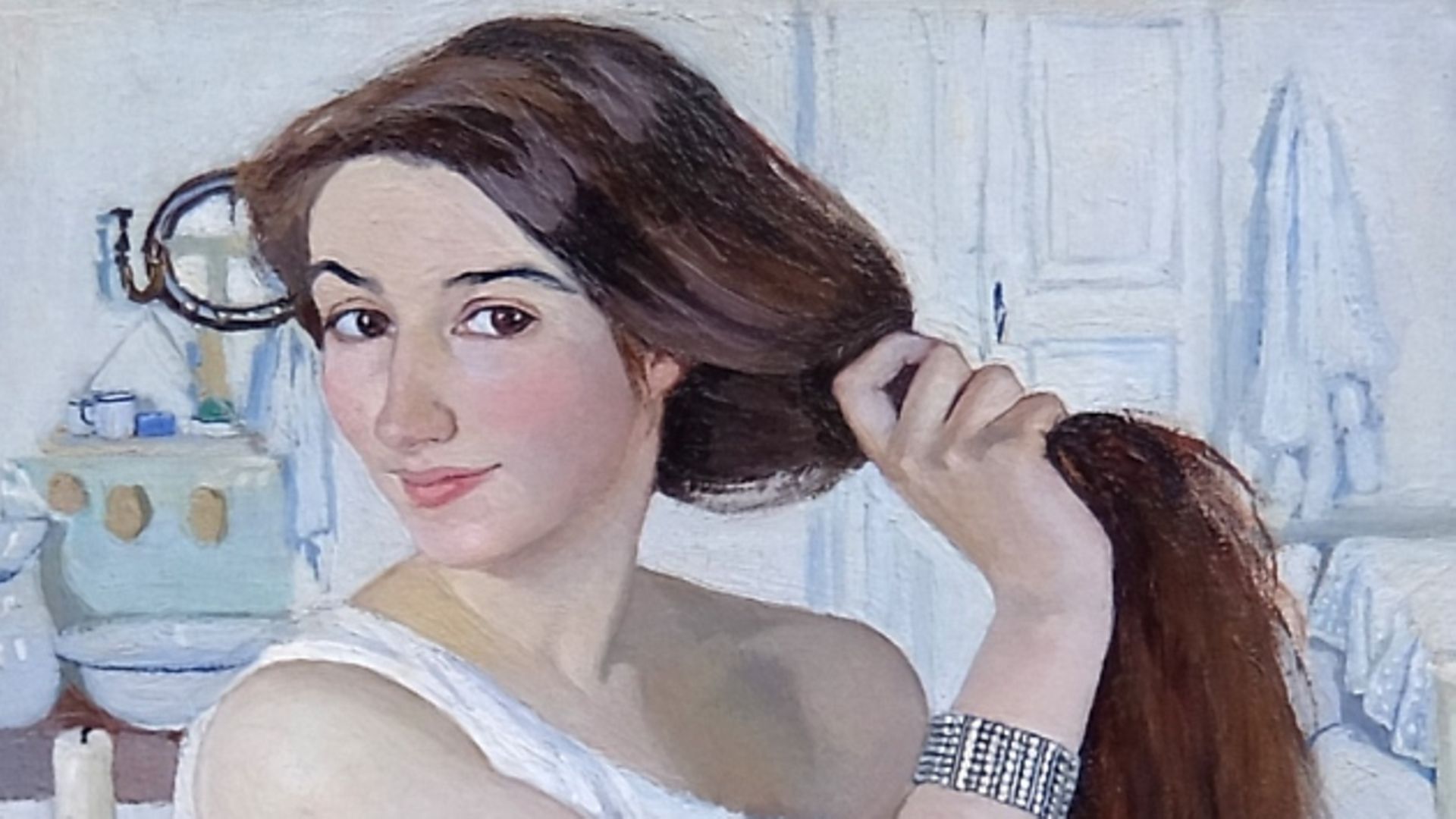The winter of 1909 came early to Russia. One morning, in the house on her family estate at Neskuchnoye in what is now Kharkiv, Ukraine, Zinaida Serebriakova looked out of the window at the snowy landscape then sat down at her dressing table. Bare-shouldered, she was grateful for the fire burning in the hearth. When she looked in the mirror and began to comb her hair Serebriakova was struck by the milkiness of the wintry light on her skin, how it made everything luminous. She put down her comb and took up her sketchpad.
The sketch turned into a watercolour that showed Serebriakova in the act of combing her long, dark hair, eyes sparkling, a smile playing on her closed lips, her dressing table strewn with scent bottles, powder puffs, a string of pearls and a small cushion stuck with brightly coloured hat pins. At the Dressing Table is joyously informal, an intimate self-portrait of a woman entirely content with life and the world.
She hadn’t painted with a view to exhibition, she just wanted to capture a moment on a morning when she felt warm and safe and happy, but her brother Yevgeny persuaded her to add the picture to the dozen or so canvases she was sending to the 1910 Union of Russian Artists exhibition in St Petersburg. At the Dressing Table was the hit of the show, so much so that it was purchased for display by the specialist fine art Tretyakov Gallery in Moscow, where it hangs to this day.
That morning as the snow fell silently outside and the flames crackled in the hearth, Zinaida Serebriakova was immersed in a decade-long period of almost unadulterated contentment. In later life she would look back on that morning, think about that portrait, and wonder if she could ever feel like that again, even for a moment.
Neskuchnoye, which means ‘never dull’, belonged to her mother’s family, the Benois, who had fled the Great Terror in Paris and settled in the cultural haven of St Petersburg during the 1790s in the culturally rich twilight of Catherine the Great’s reign. Serebriakova’s uncle Alexandre Benois was a well-known artist and a set designer for Sergei Diaghilev’s Ballet Russes. Her mother was a talented sketch artist and her father Yevgeny Nikolayevich Lanceray was a noted sculptor, ensuring art was a part of young Zinaida’s life from the cradle.
Serebriakova never knew her father, he died of tuberculosis when she was two years old, so she was brought up a Benois. Summers were spent at Neskuchnoye with the rest of the year in a sumptuous apartment next door to the Mariinsky Theatre in the cultural heart of St Petersburg. She retained a strong streak of Lanceray, however.
“Zina grew up a rather ailing and unsociable child,” wrote her uncle Alexandre, “in which she resembled her father more than her mother and sisters, who were all merry and sociable.”
She was accepted into the Princess Tenisheva Art School in St Petersburg in 1901, where she became a protégé of the noted realist Ilya Repin. Her studies were interrupted when her mother, as Serebriakova suffered a bout of ill health with a Russian winter ahead, took her to Italy for eight months where she haunted the galleries studying the Renaissance masters. Back in St Petersburg she commenced studying at the studio of Osip Braz who encouraged his students to copy portraits displayed at the city’s Hermitage gallery. Her summers on the family estate in Ukraine lent her the opportunity to work on landscapes as well as portraits, and especially the paintings of peasant women at work that would become almost her trademark. The hardships of peasant life were idealised to an extent but the pictures were vivid and full of life.
It was out in those same fields during her 21st summer at Neskuchnoye that she fell in love with her first cousin, Boris Serebriakov, a railway engineer also spending his summer in the country. After a swift courtship the couple sought and won family approval for marriage despite their being related, but it took a hefty donation to convince the Russian Orthodox Church to marry the cousins in September 1905.
Meanwhile, away from the newlyweds’ rural idyll, unrest had been building. A combination of social and economic issues fomented a wave of revolutionary uprisings that brought chaos onto the streets of St Petersburg and prompted Serebriakova and her family to relocate to Paris for the winter of 1905. With her mother she enrolled at the Académie de la Grande Chaumiere but was disappointed to find Paris engulfed by a torrent of abstractionism, a million miles from the peasant scenes, landscapes and nudes still popular at home.
By the spring of 1906 Russia was simmering but calm enough for the family to return, this time permanently to Neskuchnoye. The couple’s first child Yevgeny was born soon afterwards. Three more followed. The decade between her return to Russia and the revolution of October 1917 constituted the happiest, most settled and creatively fulfilling years of Serebriakova’s life.
The year 1917 should have marked her creative peak. She produced two of her best works, Sleeping Peasant and Bleaching Cloth that year, and was nominated for membership of the Academy of Arts. The revolution erupted before she could be ratified, however, and 18 months later Boris was arrested in Moscow during the Red Terror, contracted typhus in prison and died. In the spring of 1919 Bolsheviks arrived at Neskuchnoye, ransacked it and burned it to the ground.
Now a single mother of four children, not to mention caring for an elderly mother, Serebriakova left the smouldering ruins and made for St Petersburg. It was there in 1920 that she painted House of Cards, a study of her children around a table building a tower of playing cards. In contrast to the vivacity of her previous work all four of them look sullen and glassy-eyed, their task an utterly joyless one.
Four years of uncertainty and financial insecurity followed – frequently she had to barter paintings for food and clothing – until Serebriakova sent some of her work to a travelling exhibition in the USA where two of them were purchased for sums high enough to fund a visit to Paris in 1924. Portrait commissions had been hard to come by in St Petersburg and a spell in France might produce enough lucrative work to ward off the financial pressures at home, she thought. She wouldn’t be gone long, she told her children, and things would be better when she returned.
Serebriakova was in Paris for just a few days when the USSR closed its borders and when she tried to return she was turned away. Distraught, she remained in Paris, living frugally and sending home as much of the money she made from portraits as she could while making increasingly desperate pleas to the Soviet authorities. Grudgingly, in 1926 her youngest son Alexander was allowed to join her and two years later her daughter Katya was also permitted to leave the USSR, their joy at being reunited with their mother tempered by the wrench of leaving their siblings behind.
Both proved also to be gifted artists and between them the family managed to carve out a comfortable life in exile, creating portraits mainly of fellow Russian émigrés as well as works for exhibitions across western Europe. They never lost a sense of fracture about their existence, however, the feeling their household was incomplete.
The Second World War brought more hardship. Shortly after the Nazis arrived in Paris in 1940 Serebriakova was threatened with arrest: her correspondence with the family she hadn’t seen in nearly two decades was classed as illegal communication with an enemy nation. To stay out of the prison she was forced to renounce her Soviet citizenship, extinguishing any hope she might have nurtured of ever returning home. It would be six years before she had any further contact with her children in Russia and it would take until 1960 for her daughter Tatiana to be granted permission to visit her mother in Paris, 36 years after Serebriakova had bade her children a temporary farewell.
Tatiana proved to be her mother’s artistic champion in the Soviet Union, organising a retrospective in Moscow and lobbying for her mother to finally be allowed to return. In 1965, more than 40 years after she left, Serebriakova travelled to the Russian capital to see her own exhibition.
Eighty years old, she stood alone in front of At the Dressing Table and saw a flawless vision captured in the snowy light of a different age, a different world, a different self.











